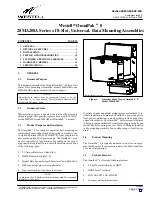
Section 28M-A20-8A0-20A
030-101678 Rev. A
R
0803IARA
9
flow and compliance with NEBS fire safety requirements, do
not dress the cables along the mounting’s top surface perfora-
tions.
3.4.3.1
4-Pin Wirewrap Connectors
For wirewrap-pin connections, stripped Facility wires are
wirewrapped" to each pin with a wirewrap tool. The Facility
Compartment cover first must be removed, then wires are
routed through the round grommet at the top right side of the
assembly. Make a small slit in the grommet, just enough to al-
low wire access, for maximum strain-relief purposes. Then
route, dress, and secure wires to the pins per company practice.
Secure the wires to the cable tie-down on the OmniPak
t
8 with
cable ties, when complete (after testing). For wiring details and
pin designations, see Figure 2 and Figure 5.
3.4.3.2
25-Pair Connectors
Facility side connections alternately may be made to the two
50-pin/25-pair Telco Facility connectors in the Facility
Compartment area. The Facility Compartment cover first must
be removed, then cables are routed through the other cable ac-
cess opening provided at the top right side of the assembly
(created when the Facility Compartment cover is set in place,
best seen in the assembled view in Figure 1). After securing the
connectors, attach drain wires to screw terminals TB2 and TB3,
route cables through the right side opening, and secure cables
to the cable tie-downs on the OmniPak
t
8 with cable ties, when
complete (after testing). For wiring details and pin designa-
tions, see Figure 2 and Figure 5.
3.4.3.3
Cable Drain (Ground) Wiring Connector
If not already performed, make all cable drain wire connec-
tions at the appropriate stud or screw. Refer to Figure 2 for the
location of these studs/screws used for cable drain (ground)
wiring. Please note only one end of the drain wire should be
connected to prevent a ground loop.
3.4.4
Customer Interface Connections
Customer side connections are made to either the 4-pin wire-
wrap connectors, to the RJ48C/S jacks, or to the 50-pin/25-pair
RJ48H connector (see Paragraph 2.2.6 and Table 1) all located
in the Customer wiring area at the bottom of the OmniPak
t
8.
See the paragraph below that applies to the customer connec-
tion method preferred. After wiring installation and testing,
secure all wires/cables with a cable tie and the cable tie-down
provided.
3.4.4.1
4-Pin Wirewrap Connectors
For wirewrap pin connections, stripped customer wires are
wirewrapped" to each pin with a wirewrap tool. The Customer
Wirewrap Pin cover first must be removed, then wires are
routed through the grommet at the bottom right side of the as-
sembly. Make a small slit in the grommet, just enough to allow
wire access, for maximum strain-relief purposes. Then route,
dress, and secure wires to the pins per company practice. Se-
cure the wires to the cable tie-down on the OmniPak
t
8 with
cable ties, when complete (after testing). For wiring details and
pin designations, see Figure 2 and Figure 5.
3.4.4.2
RJ48C/S Jacks (and 2-Position Jack Switches)
Customer connections alternately can be made via the
RJ48C/S jacks, which do not require the removal of the Cus-
tomer Wirewrap Pin cover. Firmly insert each RJ48C/S plug
into each jack. To the right of each jack is a 2-position switch ,
labelled S" at the top of the switch and C" at the bottom. If
the application requires an RJ48S-type jack, set or slide the
switch to the S" position, towards the top. If the application
requires an RJ48C-type jack, set the switch to the C" position,
towards the bottom. Each switch is recessed, for security, and
requires a narrow or pointed tool (such as a narrow screwdriv-
er) to change the setting. Secure all cables to the cable tie-down
with a cable tie, after testing. For wiring details and pin designa-
tions, see Figure 2 and Figure 5.
3.4.4.3
25-Pair RJ48H Connector
Customer connections alternately can be made via the 25-pair
RJ48H connector, which does not require the removal of the
Customer Wirewrap Pin cover. Firmly insert the connector
into the receptacle provided (labelled CUSTOMER INTER-
FACE"), then secure the cable to the cable tie-down with a
cable tie, after testing. For wiring details and pin designations,
see Figure 5.
3.4.4.4
Cable Drain (Ground) Wiring Lug
If not already performed, make all cable drain wire connec-
tions at the cable drain (ground) wiring studs/screws. Refer to
Figure 2 for the location of these stud/screws. Please note only
one end of the drain wire should be connected to prevent a
ground loop.
3.4.5
Module Installation
Both 200- and 400-type plug-in modules can be inserted into
the OmniPak
t
8 after the mounting installation is complete.
Before installing modules, set any option switches to the de-
sired positions. Align the module with the card guides above
and below the unit and insert as far as it will go into the slot con-
nector.
- NOTE -
To maintain the UL Listing of these assemblies,
only
UL recognized
modules that do not exceed the per slot" ratings outlined in Table 2
can be used. Also note that all modules will not necessarily be rated
for both AC and DC operation.
- CAUTION -
Use care when installing and removing modules -
do not force a
module into place
. If a module resists insertion, remove it and
check for obstructions in or near the connectors and mounting
slots and gently re-insert the module.
3.4.6
Re-Installing Covers and Door
When all modules are installed, the assembly door can be re-
positioned, and the locking device secured. After making all
the necessary connections, the top cover can be positioned
back into place and the thumb-screw re-tightened (manually or
with a screwdriver). The bottom cover can also be closed and
the thumb screw re-tightened manually or with a screwdriver.






























